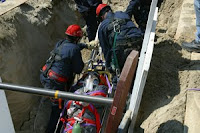
Cave-ins are one of the most life threatening situations at construction sites. OSHA has issued certain guidelines for preventing injuries and deaths that occur at excavation sites. OSHA issued the first OSHA Excavation and Trenching Standard in 1971. It has been amended several times after that, but the complete checklist is as given below:
- The first mandatory step in excavation is determining the type of soil. Cave-ins usually happen due to soil failure. The usual reasons for this are soil sliding, toppling, bulging and subsidence. Also, it is important to determine the different factors that can cause soil failure.
- All excavations that are going to be deeper than four feet have to be tested for oxygen levels and presence of different toxic gases. Where danger exists, the employers have to provide the correct breathing equipment and the atmosphere inside the excavation should be correctly regulated.
- Adequate measures should be carried out for protecting workers from falls and falling of loads and other equipment on them. Employers should take care to see that equipments liable to fall should be kept at least 2 feet away from the edge of the trenches. Dangerous situations of employees being hit by falling debris should be avoided.
Comments
Post a Comment